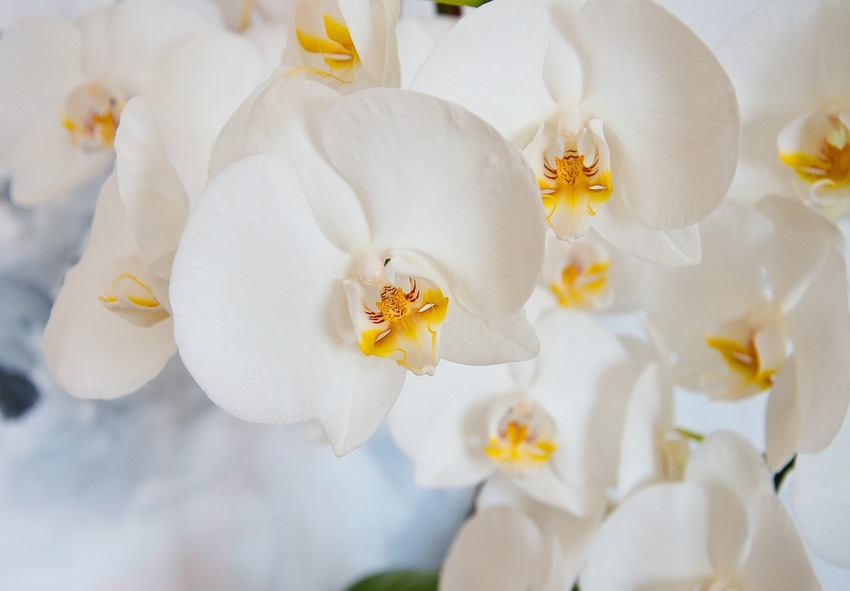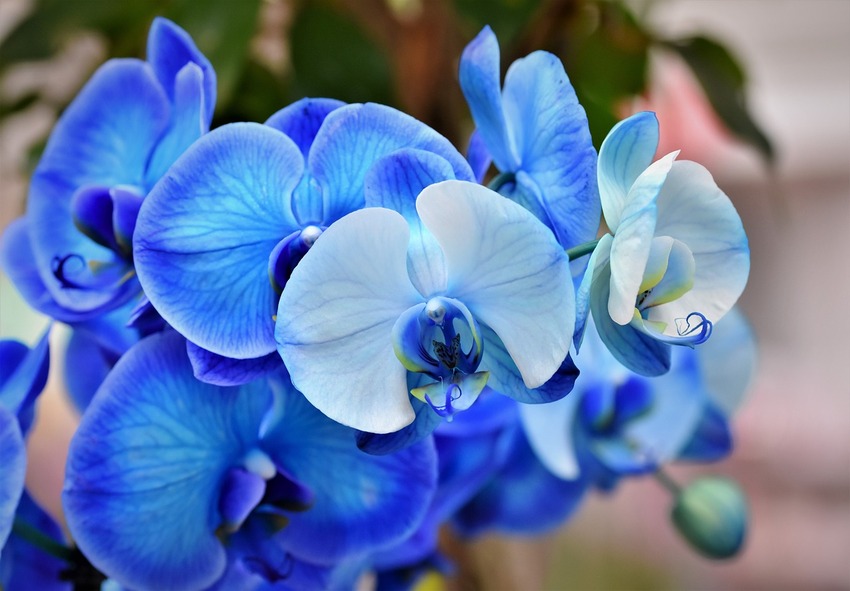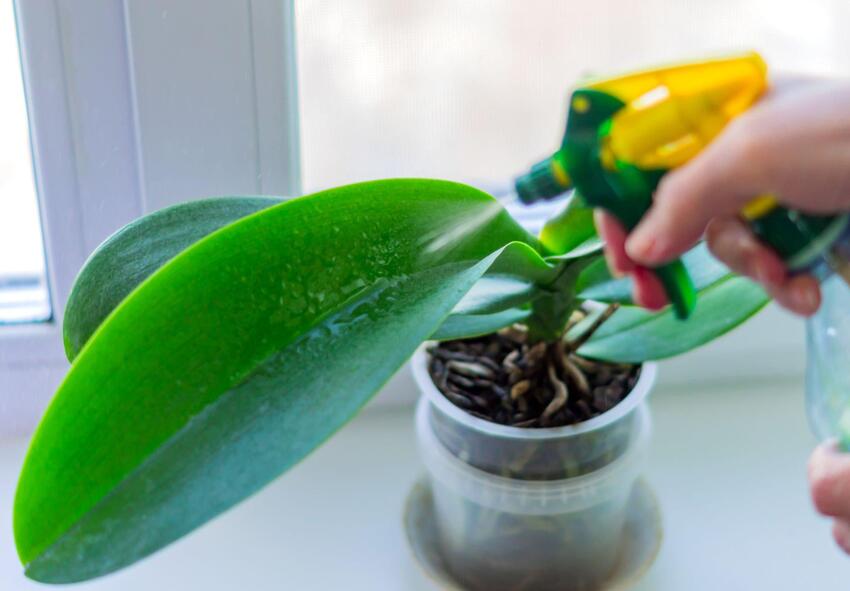Orchids are beautiful and exotic flowering plants that can add elegance to any home or garden. While they may have a reputation for being delicate and difficult to care for, with the right knowledge and attention, anyone can successfully grow and maintain orchids. In this guide, we’ll cover the basics of orchid care, including planting, pruning, watering, and general maintenance.
Orchids: A Fascinating Introduction to These Exquisite Flowers

Orchids possess immense variety and captivate with their intricate beauty. With a staggering array of over 25,000 unique species, these remarkable plants showcase an extensive range of shapes, hues, and dimensions. Orchids have earned a special place in the hearts of gardening enthusiasts and flower lovers due to their alluring charm and fragile blossoms.
| Botanical Name | Usage | Origin | Colour | Heyday | Particularities |
| Phalaenopsis | Indoor decoration, gifts | Southeast Asia, Australia | White, pink, yellow, purple | Winter-spring | Easy to care for |
| Cattleya | Cut flowers, corsages | Central and South America | Pink, purple, yellow, white | Winter-spring | Fragrant scent |
| Dendrobium | Cut flowers, decorations | Asia, Australia, Pacific Islands | White, pink, lavender, yellow | Spring | Can have evergreen or deciduous leaves |
| Oncidium | Cut flowers, decorations | Central and South America | Yellow, brown, white, pink | Spring-summer | Resembles dancing figures |
Exploring the Basics: Orchid Species and Key Facts
Before delving into the intricacies of orchid nurturing, it’s crucial to grasp the fundamental aspects of orchid species. Orchids can be categorized into two primary groups: epiphytes and terrestrial. Epiphytes refer to plants that thrive upon other plants, such as trees, whereas terrestrial orchids grow in soil.
Orchids exhibit an extensive array of colors, ranging from pristine white to vibrant pink, sunny yellow, and majestic purple. They also possess a distinctive structure, featuring a captivating lip or labellum that entices pollinators and facilitates the plant’s reproductive process. Furthermore, orchids boast a specialized root system that enables them to absorb essential nutrients and moisture from the surrounding atmosphere.
Understanding Orchid Types: Unraveling the Diversity

Orchids can be further classified into different types based on their growth habits and characteristics. Some of the most popular types of orchids include:
- Phalaenopsis: Also known as the “moth orchid,” this is one of the most common types of orchids due to its easy care and beautiful blooms.
- Cattleya: This type of orchid is known for its large, showy blooms and fragrant scent.
- Dendrobium: These orchids come in a variety of colors and can have either evergreen or deciduous leaves.
- Oncidium: Also known as the “dancing lady” orchid, this type has small, delicate blooms that resemble dancing figures.
Delving into Orchid Varieties: How They Differ and Which One to Choose
There are many different varieties of orchids within each type, each with its own unique characteristics. When choosing an orchid, it’s important to consider factors such as the plant’s growing requirements, bloom time, and overall appearance. Some popular orchid varieties include:
- Phalaenopsis “White Moth”: This orchid has beautiful white blooms and is easy to care for, making it a great choice for beginners.
- Cattleya “Orchid Queen”: With its large, fragrant blooms, this orchid is a showstopper in any garden or home.
- Dendrobium “Nobile”: This orchid has a unique, bamboo-like stem and produces clusters of delicate blooms in shades of pink, white, and purple.
- Oncidium “Sharry Baby”: This orchid has a sweet, chocolatey fragrance and produces clusters of small, yellow blooms.
Orchid Care: Essential Tips for Nurturing Your Plants
Proper care is essential for keeping your orchids healthy and thriving. Here are some essential tips for caring for your orchids:
Planting Orchids: Step-by-Step Guide for Success
When establishing an orchid’s new home, it is vital to select an appropriate potting mix and container. Orchids necessitate a well-draining mix that fosters adequate air circulation around their roots. Moreover, it is crucial to opt for a container that possesses drainage holes, as this prevents the accumulation of excess water at the base.
To successfully plant your orchid, kindly adhere to the following guidelines:
- Choose a pot that is marginally larger than your orchid’s root system.
- Fill the pot with an orchid potting mix, ensuring sufficient space for the roots to spread comfortably.
- Carefully extract your orchid from its current container, gently untangling any interwoven roots.
- Situate the orchid within the new container and fill any gaps with the potting mix.
- Thoroughly water your orchid, allowing the moisture to saturate the roots, and subsequently position it in an area with bright, indirect light.
Orchid Care Guide: Meeting Their Unique Needs

Orchids have unique needs when it comes to watering, light, and temperature.
Orchids should be watered thoroughly but infrequently. It’s important to allow the potting mix to dry out slightly between waterings to prevent root rot. When watering, be sure to soak the entire potting mix and allow any excess water to drain away.
Orchids require bright, indirect light to thrive. They should be placed in a spot with filtered sunlight, such as near a north-facing window. Orchids prefer temperatures between 65-85°F during the day and 55-65°F at night. They should be kept away from drafts and extreme temperature changes.
Mastering Orchid Pruning: Techniques for Healthy Growth
Maintaining orchids through pruning is a crucial aspect of their care, as it fosters robust growth and safeguards against diseases. Here are some recommendations for effectively pruning your orchid. Promptly eliminate any withered or discolored leaves or flowers to prevent the proliferation of ailments. Trim the stem of your orchid once it has completed its blooming cycle, stimulating fresh growth.
If your orchid has outgrown its current container, you can prune the roots and subsequently transplant it into a larger container.
Propagating Orchids: Unlocking the Secrets of Reproduction
Propagating orchids can be a rewarding way to expand your collection. Here are some methods for propagating your orchids:
- Division: Divide your orchid when it outgrows its container or after it has finished blooming. Gently separate the roots and plant each division in a new container.
- Keiki: Some orchids produce miniature plants, known as keikis, along their stems. These can be removed and planted in their own container once they have developed roots.
Overwintering Orchids: Protecting Your Plants during Cold Months

Overwintering orchids is an essential practice for orchid enthusiasts who live in regions with cold winters. Many orchid species are native to tropical or subtropical climates, and they require special care to survive the colder temperatures. Different orchid species have varying temperature requirements. It’s crucial to understand the specific needs of your orchids to provide them with the appropriate care during winter. Some orchids can tolerate cooler temperatures, while others require warmer conditions.
Most orchids that are not cold-hardy should be moved indoors before the first frost. Find a suitable location inside your home, such as a bright windowsill or an orchid grow tent. Ensure that the area has good air circulation and appropriate light conditions for your orchids.
During winter, orchids typically require less water due to the lower light levels and cooler temperatures. Reduce the frequency of watering, but make sure to monitor the moisture level in the potting medium. Overwatering can lead to root rot, so it’s important to strike a balance and avoid letting the medium completely dry out.
Orchids thrive in humid environments. Indoor heating during winter can cause the air to become dry, which can be detrimental to your orchids. Increase humidity around your orchids by using a humidifier, placing trays of water near the plants, or misting them regularly. However, be cautious not to create excessively damp conditions, as this can encourage fungal or bacterial growth.
Light is crucial for orchids’ growth and blooming. Ensure that your orchids receive sufficient light during the winter months. Place them near windows with bright, indirect light or use artificial grow lights if natural light is limited. The duration and intensity of light may need to be adjusted based on the specific requirements of your orchid species.
Most orchids prefer temperatures between 60°F (15°C) and 80°F (27°C). Avoid exposing your orchids to extreme temperature fluctuations, drafts, or cold drafts from windows or doors. Keep them away from heat sources that may cause excessive dryness or heat stress.
Cold and dry conditions can make orchids more susceptible to pests and diseases. Regularly inspect your orchids for any signs of pests like aphids, mealybugs, or scale insects. Treat any infestations promptly with appropriate organic or chemical controls. Also, ensure good air circulation to prevent the growth of fungi or bacterial infections.
Blooming Time: Discovering When Orchids Showcase Their Beauty

Different orchid species have varying blooming seasons. Some orchids bloom once a year, while others may bloom several times throughout the year. It’s essential to understand the specific species of orchid you have to determine its blooming time accurately.
Orchids are highly sensitive to light conditions. The intensity and duration of light play a crucial role in triggering blooming. Many orchids require a balance between light and darkness to initiate the blooming process. For instance, certain species of orchids, such as Phalaenopsis, require a period of reduced light or longer nights to initiate blooming.
Orchids thrive in specific temperature ranges, and these temperature variations can influence their blooming. Some orchids require a drop in temperature to trigger blooming, while others prefer consistent warm temperatures. Understanding the temperature preferences of your orchid species can help you anticipate their blooming time.
Orchids have unique watering needs, and providing the right amount of water and humidity is essential for their overall health and blooming. Overwatering or underwatering can hinder blooming. Maintaining appropriate humidity levels, especially for tropical orchid species, is crucial for encouraging blooming.
Proper fertilization can promote healthy growth and blooming in orchids. Using a balanced orchid fertilizer according to the specific needs of your orchid species can enhance its blooming potential.
Some orchids, like the Cymbidium species, have a resting period during which they require reduced watering and cooler temperatures. This resting period is necessary for the plant to store energy and prepare for blooming. Understanding if your orchid species has a resting period is crucial for predicting its blooming time accurately.
It’s important to note that individual orchid plants may have variations in their blooming time due to factors like their overall health, age, and growing conditions. Therefore, keeping a close eye on your orchids and understanding their specific requirements will help you determine when they are likely to showcase their beautiful blooms.
What You May Need for Successful Cultivation

Successful orchid cultivation requires some basic supplies. Here are some items you may need:
Choosing the Perfect Soil for Orchids: Key Considerations
For optimal orchid care, it is essential to utilize a potting mix that offers effective drainage and promotes sufficient airflow around the roots. Look for a blend that comprises components like bark, perlite, and sphagnum moss. These materials contribute to a well-draining and aerated environment that benefits orchids.
Finding the Ideal Spot to Plant Orchids: Light, Temperature, and Humidity
When it comes to planting orchids, finding the ideal spot involves considering factors such as light, temperature, and humidity.
Orchids generally require bright, indirect light. They should be protected from direct sunlight, as it can burn their leaves. East or west-facing windows are usually ideal, as they provide moderate morning or afternoon light. If your windows receive intense sunlight, you can filter the light using sheer curtains or place the orchids a few feet away from the window.
Alternatively, you can provide artificial light using fluorescent or LED grow lights. Position the lights about a foot above the orchids and adjust the duration based on the specific orchid species.
Orchids thrive in temperatures that mimic their natural habitats. The ideal temperature range varies among orchid species, but a common range is 60°F to 80°F (15°C to 27°C) during the day. Most orchids benefit from a slight temperature drop of around 10°F (5°C) at night.
Avoid placing orchids in areas with extreme temperature fluctuations, such as near drafts or heating/cooling vents.
Orchids typically prefer higher humidity levels. A humidity range of 40% to 70% is generally suitable, depending on the specific orchid type. You can increase humidity by placing the orchids on trays filled with water and pebbles. Ensure the pots are not sitting in the water but rather on the pebbles above it. Misting the orchids occasionally with water can also help increase humidity, but be cautious not to overdo it, as constant wetness can lead to problems such as fungal diseases.
Using a humidifier in the room or grouping orchids together can create a more humid microclimate.
Remember that different orchid species have varying requirements, so it’s essential to research the specific needs of your orchids to ensure optimal growth. Additionally, factors such as air circulation, potting medium, and fertilization also contribute to the overall health of orchids.
Nourishing Your Orchids: Best Fertilizer Practices
Fertilizer is essential for promoting healthy growth and blooming in orchids. Look for a fertilizer that is specifically formulated for orchids and follow the manufacturer’s instructions for application.
Where to Buy Orchids: Trusted Sources for Healthy Plants

When it comes to buying orchids, it’s essential to find trusted sources that offer healthy plants. Here are some recommended options:
Orchid nurseries: Orchid nurseries specialize in growing and selling a wide variety of orchids. They typically have a vast selection, knowledgeable staff, and maintain proper care for their plants. You can search for local orchid nurseries in your area or explore online nurseries that ship internationally.
Orchid shows and exhibitions: Orchid shows and exhibitions are excellent places to purchase orchids directly from growers. These events often feature a wide range of orchid species and hybrids, allowing you to see the plants in person before buying. You can find information about orchid shows and exhibitions through local horticultural societies or orchid organizations.
Online orchid retailers: Several reputable online retailers specialize in selling orchids. These retailers often have a wide selection of orchid species and hybrids, along with detailed descriptions and care instructions. Look for online stores with positive customer reviews, secure payment options, and a guarantee of healthy plants upon arrival.
Orchid societies and clubs: Orchid societies and clubs are passionate communities of orchid enthusiasts. They frequently organize plant sales, auctions, and swaps where members can buy orchids directly from other growers. Joining a local orchid society or club can provide access to trusted sources and knowledgeable individuals who can guide you in finding healthy orchids.
Botanical gardens and conservatories: Some botanical gardens and conservatories have plant sales or dedicated orchid sections where you can purchase orchids. These institutions often maintain excellent growing conditions and offer well-cared-for plants. Check the websites or contact your local botanical gardens or conservatories to inquire about orchid sales.
Remember to research the specific orchid species or hybrids you’re interested in to understand their care requirements and ensure they are suitable for your growing conditions. Additionally, inspect the plants carefully before purchasing, looking for healthy foliage, firm roots, and no signs of pests or diseases.
Frequently Asked Questions (FAQs) about Orchids
1. What are some essential care tips for growing healthy orchids?
Orchids are unique and beautiful plants that require specific care. First, ensure they receive adequate light; most varieties thrive in bright, indirect sunlight. Watering is crucial but can vary by type, so research your orchid’s specific needs. Proper humidity is essential, and using a humidity tray or a room humidifier can help. Fertilize regularly with a balanced orchid fertilizer, and repot your orchid when it outgrows its pot. Regularly inspect for pests and diseases to catch any issues early.
2. Can I grow orchids indoors, or do they need to be in a greenhouse?
You can absolutely grow orchids indoors! Many orchid varieties do well in typical home conditions. Just ensure they have the right light, temperature, and humidity levels. You can create a suitable environment by placing them near a south or east-facing window, maintaining temperatures between 60-80°F (15-27°C), and using a humidity tray or a humidifier in dry climates.
3. When and how should I prune my orchids?
Pruning orchids is not as common as it is with some other plants. Generally, you should only trim dead or yellowing leaves or spent flower spikes. Use sterilized scissors or pruning shears, making clean cuts at the base of the affected parts. Be cautious not to damage healthy stems or leaves, as orchids store energy in them. Regular maintenance like this will help your orchid redirect energy to new growth and blooms.
4. Where can I purchase Dutch orchids for my collection?
You can find orchids at various places. Local nurseries, garden centers, or specialty orchid stores often carry a selection of orchids. Online retailers and orchid societies are excellent resources as well. Additionally, some orchid enthusiasts offer plants through online forums or social media groups. If you’re interested in purchasing orchids online, consider researching reputable sellers and reading reviews to ensure you’re getting healthy plants.
5. Can I order orchids from your online store?
Yes, you can! Our online store offers a wide selection of orchid plants, including different varieties and colors. We take pride in providing top-quality plants that are carefully cultivated and shipped with care to ensure they reach you in perfect condition. Visit our online store to explore our collection and place your order for a delightful addition to your home or garden.
Published: 25.06.2023
